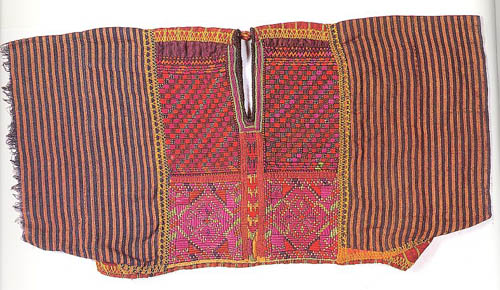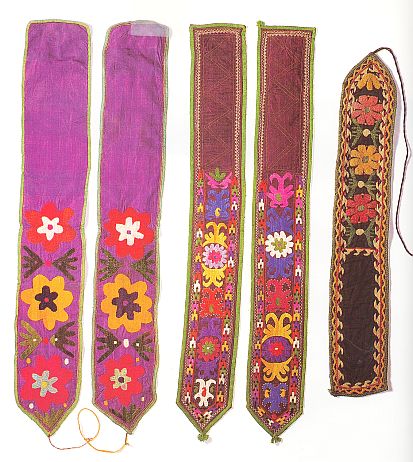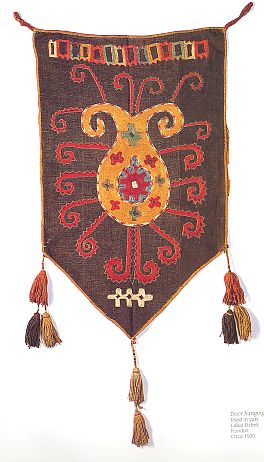by R. John Howe
Dear Folks,
As I said previously on the board, I recently bought a book by Roland Paiva and Bernard Dupaigne, entitled Afghan Embroidery.

It was published by Reforzsons (Pvt.) LTD., Lahore- Rawalpindi-Karachi in 1993, (ISBN 969 0 10143 9). It sold at publication for $45.00. The quality of the color photos seem reasonable to me, but you will have a basis for forming your own opinion.
It is an oversize format with 17 pages of introductory text followed by full color photos of 135 items of Afghan embroidery. I had seen a number of items of Afghan embroidery over the years but this book made me reconsider my impression of how interesting and beautiful it can be and how recently good work seems still to have been done. On this latter point, most of the pieces in this volume are estimated to have been made between 1920 and 1980.
The text is a little flowery and romantic, but provides useful information.
The format of each piece is given, it is attributed by ethnic group and geography and an estimate of its age is provided.

No technical information is provided for the individual pieces. Instead the written text summarizes the various stitches used in Afghan embroidery and provides drawings of each of them. Here is a listing of the stitches used:
Holbein Chain Ladder Satin Blanket Herringbone |
Long and short Satin on front Rumanain Couching Slanting Blanket Filling Cross |
There is also a description of who the Afghan embroiderers are by geographic area, ethnic group. Let me begin by summarizing what is said about this last point.
East: Pashtun, settled and nomad, Ghilzay nomads are
mentioned by name.
South: Tajiks and Pashtuns.
West: Baluch
Centre: Hazaras (the centre is a large, diverse area open to multiple influences)
North: Tajiks and Uzbeks (Turkmen in Afghanistan are said not as noted for
their embroidery as are those on the Russian side. “Chyrpys” are
mentioned but none is shown, suggesting that these are mostly products of
the Russian Turkmen.)
Now to the embroideries themselves. I will give the images and the information provided for each of them, but will frequently have little else to say. Others may be able to elaborate.
The first piece below is a striking white-ground bag.

Pashtun nomad, Katawaz (Ghazni), 1960
No dimensions are provided in this book and this is the kind of piece about which this is inconvenient, since the facing page presents four bags with the same shape but describes them as “make up bags,” making me wonder if this distinction suggests that this one is larger.
The item below is described as a Pashtun purse, Maydan, 1950

The palette of embroidered piece is distinctive and it is clear that if one collects such things, one dare not be entirely allergic to synthetic dyes. Whatever those in this piece may be, I still find them attractive.
The two pieces in the image below are plait covers, Kabul, 1930.

This is a format we have seen a couple of time here recently. There were several wonderful embroidered plait covers in the TM exhibition “Silk and Leather,” curated by John Wertime and Marshall and Marilyn Wolf brought one to a TM rug morning while that exhibition was hanging. Wertime notes that these pieces seem not have backs. This raises the question of how they were worn (i.e., kept in place over a plait).
Some of the embroideries in this book are items of clothing and the next two examples are of this sort. The piece below is a woman’s blouse front.

It is described as Pashtun Mangal, Paktya, 1930.
A second item of clothing is a man’s jacket.

Also described as Pashtun Mangal, Paktya, 1930.
And here is a third, this time a somber but spectacular “Veil.”

The two items below are described as a pair of ‘puttees.’

This is a word that I thought I had seen before, but could not retrieve its meaning from memory. A little search revealed, what some of you undoubted know, that the puttee is a covering of the lower leg from the ankle to about the knee.
I am not sure that it is not a format that originated in the West, since many of the references to it point to uses by British soldiers. Military puttees were apparently often strips of cloth that were wrapped around this area of the leg. One reference suggested the purpose was to protect the leg but also to keep stones from getting into one’s boots.
Whatever their origin they seem to have been adopted by various folks in the rug weaving parts of the world (you can find some Russian ones of the “bandage strip” sort, for sale on eBay) perhaps one of the residues of colonialism.
Anyway, this is the sort of thing that those posting here with some experience, yeah presence overseas may be able to speak to knowledgeably. Are puttees still worn? One what occasions? And how are the types presented here put on and held in place? They often have long rectangular less decorated areas but also cords coming off their pointed ends.
Just to let you see that they seem to have been recently made and worn, here are two more pairs of them in the image below.

The two pairs of puttees on the left of this image are Uzbek, Andkhoy, 1960.
The shorter item on the right is also Uzbek, but is a man’s wrist band, Sar-i-Pul, 1965.
Would someone in Afghanistan please tell us more about puttees, if you can.
The piece below is one of those that make one wish for more information on size.

It might be conjectured that this piece would be a couple of feet square but it is described as a “Make-up bag,” Hazara, Jaghori (Ghazni), 1950. Likely a simpler design to embroider but a wonderfully rich result for me.
Here are two items that have more familiar shapes to many of us.


They are both described as “Door hanging ornament, used in yurt, Lakai Uzbek, Kunduz, 1930.” I quite like how they demonstrate that both brighter and darker palettes can be effective.
Here I want again to put up the image on the front cover of this book.

Hats seem to be the format most exposed now to commercial pressures and many, many are made explicitly for sale. Still styles seem to be maintained and the authors say that a member of a given ethnic group in Afghanistan would not wear the cap of another ethnic group. This is one of the older items in this book. It is described as a “Child’s cap, Uzbek, Balkh, 1920. It seems to me a very worthy item indeed. I would collect it in a minute.
Here is another cap below, this time for a woman.

It is described as Uzbek (Tashkent tradition), Mazar-i-Sharif (Balkh), 1930.
The format below was new to me, but not a surprise once named.

That authors call this a “Coiffe,” a hair covering, perhaps worn under a veil. This one is attributed to the Uzbeks of Andkhoy, 1930. I don’t think I’ve actually seen one in the fabric.
The last two items are a kind of puzzle, they are both Yomut Turkman. I don’t think that it is generally held that there are noticeable numbers of Yomuts in Afghanistan but these two pieces are here in a book about Afghan embroidery.
The first is this rather dramatically-shaped woman’s cap.

It is attributed to Turkmen Yomut, Herat, 1940.
The second Yomut item is this purse.

Also attributed to the Turkmen Yomut, Herat, 1930.
So that is what I can show your from this nice book on Afghan embroidery. Perhaps others can share now about this area. I hope so, since I’ve said nearly everything I know in this area. And most of that is, as usual, from the literature.
Regards,
R. John Howe